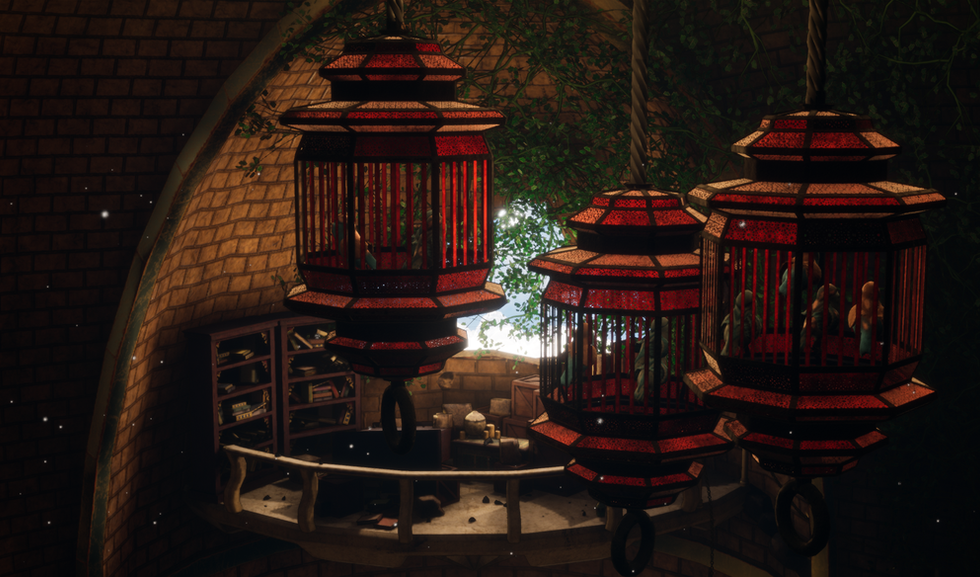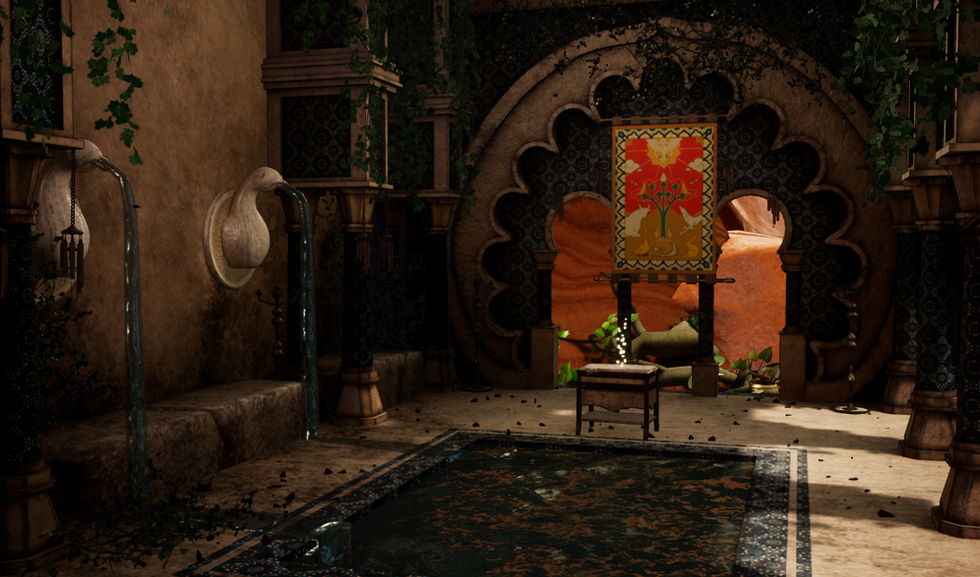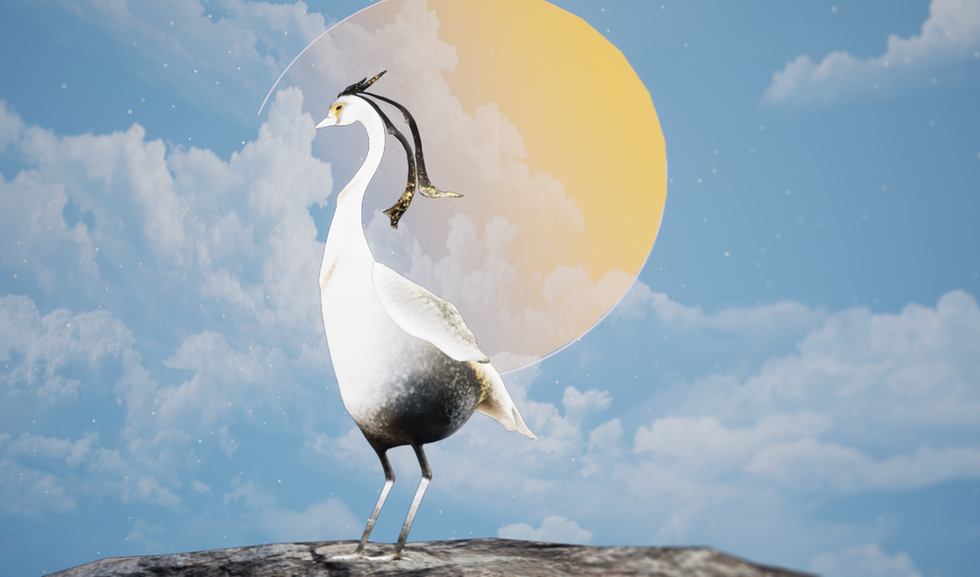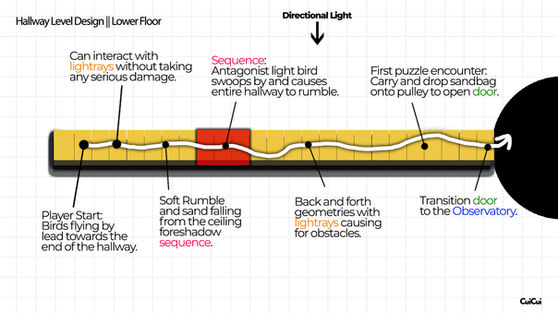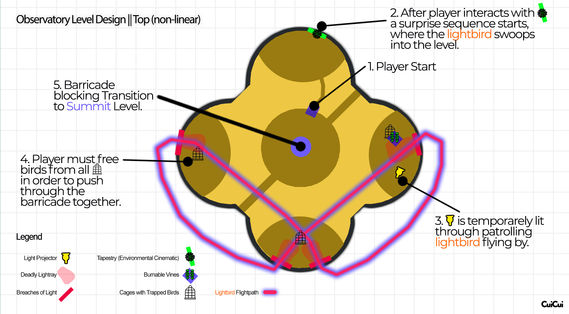Felix Faeh
Level Designer
CuiCui
Design & Breakdown
Inspirations
CuiCui has had a wide array of inspirations in design and art. We were strongly inspired by Islamic architecture, in particular more taller structures coming from the religion, such as minarets and mosques drove the design for the levels.
Two of the key inspirations for us were Moorish architecture in Spain, such as the Alhambra, as well as traditional Persian pigeon towers, which often can be found in modern day Iran.


Although Cui Cui's architecture assets lean more towards realism, we did make the decision to implement a stylized shader, opting for a semi-realism look with a touch of fable book like apperance.
When constructing the levels and puzzles, we often drew inspirations from games like the Uncharted series (by Naughty Dog), since we wanted an experience that was akin, leaning on a linear story driven experience with a pleasantly balanced mix of adventure, action, story and puzzles.
When chasing the ethereal and airy feel of CuiCui, we were invoked by one game in particular, namely Journey (ThatGameCompany).


Gameplay Design

CuiCui's gameplay is comprised of simple puzzles with minimal mechanics that lean towards a linear narrative as we wanted to orchestrate more on the ethereal experience. The focal point was set on immersion, environmental storytelling, mood and ambiance.
Flying is a very vital part of the experience, which was one of the mechanics, we worked on from the start of development up until finish. It took many iterations and we often fluctuated between floaty, arcady and more realistic behaviors, with the debate between ease of play versus immersion. In the end, we opted for an in between solution, since either extreme felt wrong. We wanted immersion, but not at the cost of an intuitive feeling movement.
Being caught in to the open light will kill the player near instantly, which means the player should always stick to the shadows, if possible.
Puzzles
In order to advance, the player must make use of the very thing, that could kill them: The light. Puzzles scattered around the levels are all based around light. The first type of puzzles in CuiCui involve accessing light projectors where the player can target and fire light beams around the environment in order to burn certain objects like dried up vines, allowing them to advance through the level. The player can rotate these projectors, but must avoid getting caught in the trajectory themselves. By moving a light beam from one projector to the other, they can essentially transport the light through the level.


Left Image: Projector Turned Off || Right Image: Projector Turned On
The Main Antagonist
The NPC's the player will meet on the adventures are always birds and while most are friendly towards the player, one larger bird poses a great danger to the player. Since the player can die near powerful light sources, only being caught and close the majestic bird Azhar will cause the player to almost disintegrate immediately.
Azhar is the mysterious entity in our game. The bird patrols the observatory and also the summit, seemingly protecting the heated sun, trying to shoo away any interlopers, such as Cui from nearing it.
Throughout the game, we designed Azhar's presence to increase. At first we sprinkled in some foreshadowing in the hallway (first part), by having him rush by in the blink of an eye. Whereas in the observatory (second part), Azhar swoops in an unexpected sequence, patrolling the upper areas, not quite cognizant of the players presence, but hostile nonetheless. Azhar's presence is however strongest felt in the summit level (final level), where now filled with rage, he will actively cause chaos, trying to hunt down Cui and end her journey as well as harming the other birds.
Having buddy birds by the player's side will give the player shadow. The flock will help shield Cui from Azhar's light for sometime, before one bird at a time will leave, due to the very high temperatures.

Azhar, the majestic light bird and main antagonist becomes a more menacing threat, the further the player advances.
Discoverable Cinematics
In order to further the environmental storytelling, we opted for a fable like feel, which is why we added in smaller segments of short cinematic story telling in the form of historic tapestries that can be discovered by the player.
When interacting with a tapestry (Pop up Button click nearby), a camera sequence will play zooming in on the tapestry art, slowly panning over the relevant imagery, as voice over and music plays along. As the cinematic ends, the camera is returned to the player.
These tapestries were designed to give diversity to the gameplay and let players receive a reward, when advancing into a new area. Through engaging with all tapestries, the player an learn the ultimate fate that led up to the soaring and glowing heat. Everything is relevant to the player's current story.

Interactive Tapestry, that will play a short story cinematic are found throughout the game.
Level Design
Since CuiCui has a larger focus on a single narrative, we opted to create a linear story-driven experience, with larger spaces containing puzzles for the player to accomplish. Cui is at all times very tiny compared to the scale of the spaces.

Light has its own characteristic in our game. Since it is deadly for Cui to cross over beams, we had to make sure that the light beams would stand out, so we gave them their own unique volumetric appearance with sharp outlines. Since many of the puzzles and hurdles revolved around lights, we decided to choose environments for our levels with open windows, broken walls and a mix of shades and sun, while we could deploy the light bird Azhar from our toolkit as a dynamic threat.
Among the design challenges we faced along the way, was being restrained from using light as a focal point within the players view. In many games, light casts are used in the environment to lead the players vision to move towards a specific spot. In CuiCui that would lead the player straight to their death, so we had to make a stronger use of geometric lines, color glyphs and short cinematic camera swoops instead.
We were careful to never exactly state what these spaces are to the player. We found an exciting part was for them to be able to inquire each space they visit. We had set a focus on environmental storytelling, with little details scattered in each level, telling the story of that space.

First Area: Hallway
The Hallway was designed to be a calm introduction level. Here there is little danger in the way and most lights are static. It is the ideal spot for the player to test the bare mechanics and get used to flying, while still having a few dangerous obstacles in their way. We added in a couple of broken walls and pillars, that would lead the player to ascend and descend between openings.
Additionally, there is a sequence that starts as the player reaches the center of the hallway. The light bird Azhar will briefly and swiftly soar on the outside walls passing the arches, its light narrowly brushing over the entire hallway, foreshadowing a greater encounter ahead for the player and bringing a sudden tension. Although the light would harm the player, it goes by too fast to do any real damage.

Second Area: The Observatory
The Observatory is much more vertical in nature and centered around puzzles, in particular projectors that might have been used prominently in an ancient human age. The observatory now stands abandoned, with nature reclaiming back the structure through overgrowing plants. Here the player will circle around the entire observatory interior, since there is a tall cylindrical structure in the center and walls that connect around it. As the player circles, they will also ascend upwards into the balcony spaces.
Up there, they will encounter many birds that were trapped in cages by Azhar. By freeing these non-shadowy birds they will help the player, by surrounding them, flocking together and giving the player immunity from light sources, as they provide shadow. Although the soaring light does affect these birds, they will still fly away one by one, if the flock is directly hit by the light. The player leaves the observatory through a small narrow tunnel in the center of the structure.

Third Area: The Summit
Leaving through a confined opening from the observatory, the player will first be greeted by outside world, as they descend a long and narrow walled path. But as they venture forward, they will experience a decompression, entering a sudden wide open space and focal vista of the game. The flooded temple area. There, the player will find a tranquil pool with many friendly birds, a small and heartfelt respite before the rest of the game ramps up drastically in tension.
Out here, there are only a few puzzles, as the player will have to instead rely on movement and reflexes.
Since this is an outside level, the player has far less options to hide from the direct light, and has to sing to friendly birds, in order for them to flock around Cui, creating a protective barrier. The summit is marked by many extremes in our game.
After the player flies beyond the pool, Azhar will frantically keep attacking Cui. In order for the player to advance, they need to continuously gather birds around them, building a bigger flock, as they ascend the towers and onto the final plateau, where they will have a final encounter the games main antagonist.


Level Mapouts
Post Mortem
Much of how we approached CuiCui was more open in nature. We didn't define a specific genre beforehand, but instead honed in to combine and test new experiences, allowing the genre to form after. We wanted to challenge ourselves and approach development with an open mind and see where it would take us.
Early Stages
Early development on CuiCui involved working on the 3Cs, parallel to creating test looks of the art and mood, as well as level block outs for play testing. A heavy focus was set on getting the movement to feel good. Cuis first character model was being created by the side.
We found a lot of power in working through Agile Scrum and arranging a source control in the form of Perforce. It brought us ease in development, allowing us work flow to run smoothly. After the first 3 months, we finished two of our three levels, the Hallway and Observatory, polishing and expanding them after.
We took early feedback and were adamant on bringing in new players to test the game, as often as we could. We were looking for fun in the gameplay and playtesting helped us define our core mechanics with much more ease. Through interviewing testers, we found that people had quite a few of differing opinions and it helped us define our audience in UX terms. We mostly saw two camps. One group preferred an Arcady floaty feel of movement and the other group leaned more towards realism. We ultimately opted to create an in between feel, that would suit the design.
Mid - Later Development
Next up for us was the third and final level, the Summit. Overall, this environment and level was more ambitious in its scope, given the time and polish our game needed in addition. There were quite few fixes needed. Something we had to tackle head on, as the work quadrupled towards the end of development, since we worked diligently on optimization, fixing and balancing.
One of these changes we adopted was to make an entirely new model for Cui, adding on a new rig and redoing the animations and adapting the new model into the existing blueprint, since we as a team did not feel content with the earlier model and appearance. It was a though decision for us, but we ultimately felt it was the fight decision.
There were a couple of occasions, where we were chasing short term deadlines and creating prototypes to please the showcase, as opposed to sticking with a coherent design, throughout, which caused challenges. The balance between adhering to short-handed feedback and following our mapped-out design, was something tricky, yet invaluable to navigate. It was something that brought us self-reflection and a lot to learn for the future.
Ending Note
CuiCui was a university project and as such, as the Lead Designer I advocated for the team to try out new designs and styles. I felt it was much more important to try something risky and potentially experience defeat, then to stick to something mundane that would rather easily succeed. We were a group of very talented individuals and I felt each needed to be able to extend their reach and let their creativity go, as opposed to tightly controlling the design. It was ultimately what I found defining to my own approach, as I felt strongly that it was how I wanted to conduct myself on this team specifically.
We were ambitious times and fatigue kicked in, but the team was always very much behind the designs, motivated and hard working. We did not shy away from experimentation, since our environment proofed ripe for it. When all is said and done, our team was left with a unique, beautiful and immersive game and experience.







